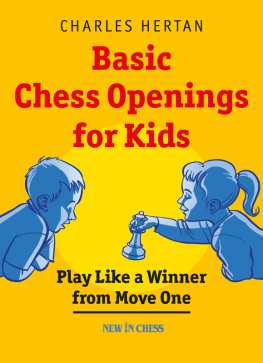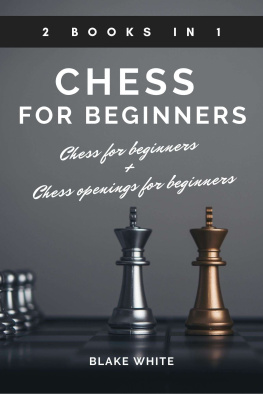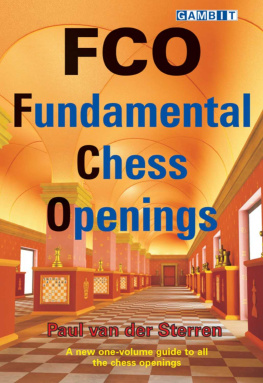Basic Chess Openings for Kids
Charles Hertan
Basic Chess Openings for Kids
Play Like a Winner from Move One
New In Chess 2015
This book is dedicated to my wife, life companion and biggest supporter, Rhonda.
2015 New In Chess
Published by New In Chess, Alkmaar, The Netherlands
www.newinchess.com
All rights reserved. No part of this book may be reproduced, stored in a retrieval system or transmitted in any form or by any means, electronic, mechanical, photocopying, recording or otherwise, without the prior written permission from the publisher.
Cover design: Volken Beck
Supervisor: Peter Boel
Proofreading: Ren Olthof
Production: Anton Schermer
Have you found any errors in this book?
Please send your remarks to editors@newinchess.com. We will collect all relevant corrections on the Errata page of our website www.newinchess.com and implement them in a possible next edition.
ISBN: 978-90-5691-597-1
Explanation of Symbols
The chessboard with its coordinates:


| White to move |

| Black to move |
K | King |
Q | Queen |
R | Rook |
B | Bishop |
N | Knight |

| White stands slightly better |

| Black stands slightly better |

| White stands better |

| Black stands better |
+ | White has a decisive advantage |
+ | Black has a decisive advantage |
= | balanced position |
! | good move |
!! | excellent move |
? | bad move |
?? | blunder |
!? | interesting move |
?! | dubious move |
unclear |
# | mate |
Cast of Characters

| Zort from Zugzwang: A teenaged computer from planet Zugzwang. His favorite hobbies are chess, facebook and googling. Zort uses his amazing computer board sight to show whats really going on in complicated variations and key positions. |

| The chess professor answers kids questions with wit and wisdom, giving you important winning tips! |

| The Dinosaurs The Dinosaurs stand for players in the first great chess tournaments, from the 1850s to the 1890s. Like Tyrannosaurus Rex they were crude and deadly, always playing for the kill and producing many sharp battles. |

| Power Chess Kids Chess kids of the world ask typical kids questions about winning opening strategy. |
Introduction
Having been a chess coach for over four decades, I have taught hundreds of kids, from beginners to strong tournament players, how to sharpen their chess skills. One important area that children are very interested in is how to begin the game. Masters have a grasp of key ideas at this stage, which makes it almost easy to find strong moves. Without this knowledge, kids flounder and make whatever move comes to mind, with no clear purpose.
Opening books for adults stress memorizing opening variations. These are sequences of moves that have been tested in master games. Unfortunately, most kids opening books copy this approach. Memorizing is important for advanced tournament play, but not useful or necessary for kids who are just starting out. Instead, the first step should be learning the goals and priorities of opening play, and how each piece can best be used to meet these goals. Kids who absorb these guiding ideas, will learn how to get a strong opening position without having to name or memorize specific variations. In this book, chess-loving children will be introduced to the names and basic ideas of many important chess openings, but for a different reason: to illustrate the basic principles of strong opening play. First, you will learn how to find a strong move for each piece in many different opening situations, and how to get your pieces and pawns working together as an effective team. Only then will we take a closer look at some opening variations, so that kids who want to study further can begin to learn more about using these ideas to understand the goals of specific openings.
What Is the Chess Opening?
Most activities have a beginning, a middle, and an end. In chess its not so simple! The opening does mark the start of a chess game, but it means much more. Sometimes its useful to think of chess as a battle between two opposing armies. In fact, the chessmen represent typical combatants during the Middle Ages (the years 400-1500 AD), when the modern rules of the game were established. Using this metaphor, the opening is the phase in which you prepare your army for battle. When both sides are fully prepared, the next stage is the middlegame, when plans of attack are devised, to achieve an advantage of position or material (having more men), with the ultimate goal of checkmating the enemy king. The endgame is a phase in which many pieces have been traded, so the king is in less danger of checkmate. Then the battle often includes trying to promote a pawn into a queen, and use the extra queen for a checkmating attack.
Heres something unique about chess while the opening starts the game, sometimes its also the end! In this case we say that one side never made it out of the opening. A player may fail to prepare his forces, or make a terrible mistake and get checkmated right away! Although there are three possible phases of a chess game, many battles never get beyond the opening stage. A good opening gives you much better chances to win the game, so learning the basics of strong opening play is extremely important.
Whats the Goal of the Opening Phase?
This is a great question, because most kids have only a vague idea what theyre aiming for at the start of a game. They make one move here and another there, and may tell you they have a new plan each turn. Unfortunately, the plan often has nothing to do with good opening play.
The main goal of the opening can be boiled down to one sentence:
Get your pieces into action quickly and effectively!
Next page























